|
|
Animations & Video
Galaxy Clusters
 |
Best of Chandra Images:
Groups & Clusters of Galaxies
QuickTime
MPEG
Among the most energetic events in the universe is the merger of groups
of galaxies to form giant clusters containing thousands of galaxies.
Vast, hot, X-ray emitting gas clouds in the clusters show this process
in action. This video presents some of the best Chandra observations of
groups and clusters of galaxies.
[Runtime: 0:57]
Animation: CXC/A.Hobart
Field Guide: Groups & Clusters of Galaxies
|
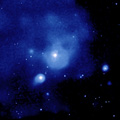
|
Dissolve from Optical to X-ray View of Fornax
QuickTime
MPEG
This sequence begins with a wide-field, visible light view (yellow) of
the Fornax galaxy cluster. Next, it zooms into the region Chandra
observed in X-rays (blue). Scientists think the core of the cluster,
labeled as NGC 1399, is moving to the lower right on a collision course
with another group of galaxies seen only in the optical data. This
indicates that the cluster lies along a large, unseen, filamentary
structure composed mostly of dark matter that is pulling everything
toward it. Two other galaxies in the Fornax cluster are labeled: NGC
1404 and NGC 1387.
[Run Time: 0:11]
(Credits: Optical: Pal.Obs. DSS;
X-ray: NASA/CXC/Columbia U./C.Scharf et al.)
Photo Album: Fornax Cluster
|
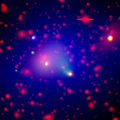
|
A Closer Look at Abell 2125
QuickTime
MPEG
This sequence shows different views of the galaxy cluster known as Abell
2125. The first image is Chandra's X-ray view where red, green, and blue
represent low, medium, and high-energy X-rays respectively. The view then
dissolves into an image of Abell 2125's core where red is optical emission,
and green and blue reveal the X-ray structure. Finally, the sequence zooms
into a close-up of C153, a galaxy that's being ripped apart as it travels
through the Abell 2125 cluster. Here, the red color represents visible
light as seen by Hubble, and green and blue once again show the X-ray
emission observed by Chandra.
[Run Time: 0:13]
(Credit: X-ray: NASA/CXC/UMass/Q.D.Wang et al.; Optical: NASA/STScI)
Related Chandra Images:
Photo Album: Abell 2125
|
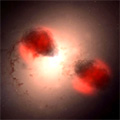 |
Abell 2597 Animation
QuickTime
MPEG
Relics of an ancient eruption in a cluster of galaxies known as A2597 have been found by the Chandra X-ray Observatory. These relics, called "ghost cavities", appear as voids in the X-ray and radio
emission. The discovery implies that galaxy clusters are the sites of recurring energetic explosions.
[Runtime: 0:30]
Animation: CXC/D.Berry
Still Photos
Related Chandra Images:
Photo Album: Abell 2597
|
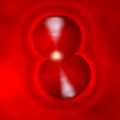
|
Animation of Sound Waves Generated in Perseus Cluster
QuickTime
MPEG
This animation shows how sound waves are generated in the Perseus cluster from its central supermassive black hole. The gas that fills the cluster of galaxies is shown in red. The animation then zooms in to show the cluster's central black hole, which is seen as a white point. Next, blue-white jets of high-energy particles and magnetic fields blow out from the black hole, forming dark cavities in the cluster gas. When these cavities slow down, sound waves break off and travel away from the cavities. The animation then dissolves into Chandra's X-ray image of the cluster.
[Runtime: 0:16]
Animation: NASA/CXC/A.Hobart
X-ray Image: NASA/CXC/IoA/A.Fabian et al.
Related Chandra Images:
Photo Album: Perseus Cluster
|

|
Perseus Ripple Image Dissolving into Illustration
QuickTime
MPEG
This sequence begins with the Chandra data, which show the ripples inthe hot gas that fills the Perseus cluster. The features were discovered by using a special image-processing technique to bring outsubtle changes in brightness. These sound waves are thought to have been generated by cavities blown out by jets from a supermassive black hole(bright white spot) at the center of the Perseus cluster. The Chandra image then dissolves into an artist's illustration of the system, which labels the important features, before returning to the original Chandra data.
[Runtime: 0:15]
X-ray Image: NASA/CXC/IoA/A.Fabian et al.
Illustration: NASA/CXC/M.Weiss
Related Chandra Images:
Photo Album: Perseus Cluster
|
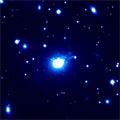
|
Optical Perseus Image Dissolving into X-ray Image
QuickTime
MPEG
This sequence of two images begins with an optical, ground-based image of the Perseus galaxy cluster. At the center of the image is Perseus A, a large elliptical galaxy. The Chandra X-ray Observatory image shows the supermassive black hole at the center of Perseus A, seen as a white point. The hot cluster gas is seen as diffuse emission, and two cavities in the cluster gas are visible on either side of the black hole.
[Runtime: 0:06]
Optical Image: NASA/CXC/IoA/A.Fabian et al.
X-ray Image: NASA/CXC/IoA/A.Fabian et al.
Related Chandra Images:
Photo Album: Perseus Cluster
|
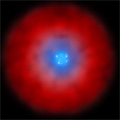
|
Artist's Representation of "Cooling Flows" in Galaxy Clusters
QuickTime
MPEG
The detection of intergalactic sound waves may solve the long-standing mystery of why the hot gas in the central regions of the Perseus cluster has not cooled over the past ten billion years to form trillions of stars. This graphic contains a series of four illustrations to show how "cooling flows" are expected to affect the structure of galaxy clusters. The hot, X-ray emitting gas that fills the cluster is shown in red. Next, the gas near the center of the cluster radiates energy and cools, which is shown as blue. The resulting inward flow of gas should cause higher densities toward the center of the cluster (brighter blue), and the final frame shows how this is expected to generate prodigious star formation.
[Runtime: 0:10]
Illustrations: NASA/CXC/M.Weiss
Related Chandra Images:
Photo Album: Perseus Cluster
|
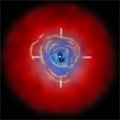
|
Artist's Representation of Sound Waves Preventing a Cooling Flow in Perseus
QuickTime
MPEG
This graphic contains a series of three illustrations to show how a "cooling flow" in the Perseus cluster, and the resulting star formation, is prevented by sound waves generated by the central black hole. The hot, X-ray emitting gas that fills the cluster is shown in red. Next, the gas near the center of the cluster radiates energy and cools, which is shown as blue. The third frame shows heating by the sound waves, shown in yellow, preventing further cooling of the gas. This stops the inward flow of gas expected in a cooling flow, preventing new star formation.
[Runtime: 0:08]
Illustrations: NASA/CXC/M.Weiss
Related Chandra Images:
Photo Album: Perseus Cluster
|
Note: High Res movies are very high quality and therefore large. They are best for 56 Kbps connections or faster. Low Res movies are not as high quality, are smaller and are
better for slower connections, 33.6 Kbps or slower.
Problems Viewing?
|